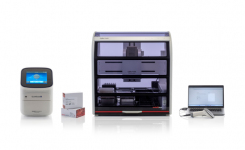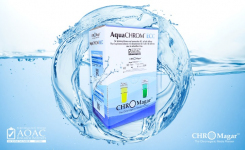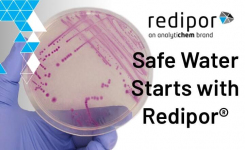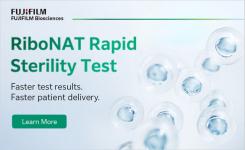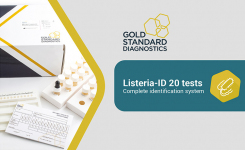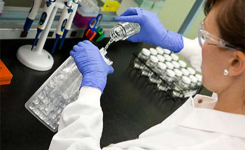
Article by Linda Everis, Microbiologist, Campden BRI
The shelf life of a product is defined as the time that a product remains safe and retains the desirable attributes of product quality with respect to chemical, sensory and microbiological characteristics. This encompasses the need to be free from undesirable food borne pathogens and to maintain an acceptable level of spoilage organisms. It is illegal to sell food which has deteriorated during storage so as to be injurious to health, or if its quality has deteriorated beyond that which would normally be acceptable.
The assignment of shelf life is very important. If it is too short (i.e. over cautious) then manufacturing costs may be high, wastage high and profit margins low; if it is too long then there is the potential for food spoilage or growth of food pathogens - and the product will not meet the requirements of food safety legislation. It is therefore important to assign the shelf-life in a systematic and scientific manner, taking all relevant factors into consideration. Evaluation of shelf life is also important when products are reformulated; minor changes in product reformulation can have a major impact on growth of microorganisms. Changing or reducing levels of a preservative, or reducing the salt, sugar or fat levels or types can all impact on shelf life. Any product formulation change should trigger a re-evaluation of the product's shelf life.
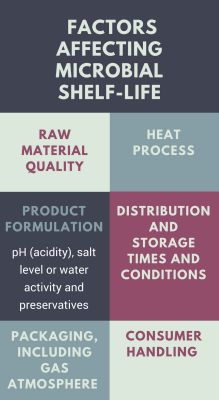 Factors Affecting Shelf Life
The shelf life of a food product is influenced by many aspects of manufacturing, product formulation and storage conditions; the effect of these on the growth of target microorganisms must be considered.
Factors Affecting Shelf Life
The shelf life of a food product is influenced by many aspects of manufacturing, product formulation and storage conditions; the effect of these on the growth of target microorganisms must be considered.
The food processor or manufacturer should have enough knowledge of its product to be able to determine what factor is going to limit the product's shelf life, and the approximate time for which the product will remain fit for eating (i.e. days, months or years). This will include comparison with similar products and a clear insight into the differences between these 'similar' products and the product in question. When microbiological issues are important, there are three basic approaches that are used to assess product shelf life: shelf life trials, challenge tests and predictive microbiology. Each has a role to play in assuring the safety of the product shelf life chosen.
Shelf Life Trials Shelf life trials are designed to answer the question: for how long does this product remain within the designated quality parameters during normal production and storage conditions? Such tests only assess the growth of micro-organisms naturally present in the batch of product tested. Shelf life testing will not be able to assess the potential for growth of foodborne pathogens because it is unlikely that pathogens would be present in product.
The shelf life of food products is determined in a logical sequence of events:
- Kitchen/pilot scale assessment: the product and process characteristics are defined and a target shelf life decided.
- Factory scale trials: the majority of laboratory testing is done on batches of product produced under routine manufacturing conditions and where the shelf life of the product is assigned. During this stage, the product is stored under conditions to which it is likely to be exposed during retail distribution and examined for any changes in levels of target microorganisms.
- Full scale production: any changes to the shelf life are monitored.
It’s important to note that the shelf life determined in these studies is only relevant to the product formulation and storage conditions used and cannot be extrapolated to other conditions.
Challenge Testing Challenge testing is designed to answer the question: Will the product formulation and storage conditions control growth of pathogens (or spoilage organisms) during the designated shelf life if they were present in the ingredients or contaminated the food during manufacture? During challenge testing a food is deliberately inoculated with the relevant organisms and the growth of the organism is studied under controlled laboratory conditions. The advantage of this technique is that it provides data to answer the ‘what if’ questions that may not be answered during shelf life studies, e.g.
- what would happen if Listeria monocytogenes contaminated my product after cooking?
- what would happen if a preservative resistant yeast survived the processing?
Predictive Microbiology Predictive microbiology involves the use of computer simulations to predict the likely growth of spoilage organisms or food pathogens in different product formulations or storage conditions. It provides a rapid answer for use in new product development and trouble shooting situations. Data can be obtained on the length of lag time, rate of growth, time taken to reach a target number of organisms, and effect of different storage regimes. In addition, many models can be used to predict the effect of fluctuating temperature profiles or changes in pH as may be seen during manufacture of fermented foods.
A more comprehensive description of predictive microbiology is available on our website.
Conclusion The shelf life of food products is influenced by microbiological, chemical and sensory considerations and, in some cases, legislative requirements. Shelf life needs to be determined by following sound scientific principles that can take into account all the relevant formulation, manufacturing, distribution and storage factors. The shelf life determined is unique to the product and storage conditions tested and cannot be extrapolated to other products or storage conditions. Assigning the correct shelf life can be the key to the commercial success of a new product and should be done in the early stages of new product development.
If you want to learn more about shelf life testing and how to approach shelf life testing then you might be interested in our course - Setting Shelf Life: How to do it better on 22nd June 2017.
More information on challenge testing is available in: Betts, G.D. (2010) Challenge testing protocols for assessing the safety and quality of food and drink. Guideline No. 63, Campden BRI, Chipping Campden, Gloucestershire, GL55 6LD.
More information on shelf life testing is available in: Betts, G.D., Brown, H.M. and Everis, L.K. (2004) Evaluation of product shelf life for chilled foods. Guideline No. 46, Campden BRI, Chipping Campden, Gloucestershire, GL55 6LD.

About the author: Linda Everis has a B.Sc. in Biology from the University of Wales Aberystwyth and is currently a Principle Research Officer in the Microbiology Safety and Spoilage section in the Microbiology department at Campden BRI, Linda’s key areas of responsibility include: Predictive microbiology, Challenge testing, Shelf life analyses and Fresh produce decontamination. She is the co-author of several Campden BRI publications. She also lectures on food poisoning and food spoilage on the many microbiology training courses that run at Campden BRI.








